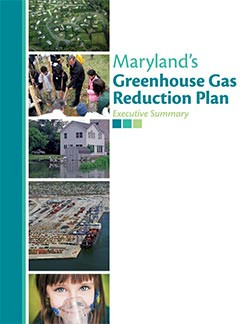Maryland releases a Greenhouse Gas Reduction Plan
Bill Dennison ·The first five sentences of Maryland’s Greenhouse Gas Reduction Plan summarize what we need to know and do. 1) Climate change is real. 2) Scientists agree. 3) It’s happening now. 4) It’s harmful and human caused. 5) We can make a difference through our actions. These simple statements are backed up with a wealth of scientific information, but one just needs to look around at the record-breaking weather events in Maryland and beyond to validate these statements.
Maryland is particularly vulnerable to climate change. Rising sea levels, higher temperatures and prolonged drought punctuated by more severe storms will affect every Maryland resident. Climate change is not theoretical for Maryland—it is quite real. We do not have to rely on climate model projections to assess climate change in Maryland. We have data on rising sea levels, warmer temperatures, decreasing air and water quality, and changing rainfall patterns. These trends already exist.

Maryland largely escaped the wrath of Superstorm Sandy late last year, but the impact to other mid Atlantic states provides a poignant reminder of our vulnerability. The 2011 drought led to agricultural market losses of at least 30% in some parts of the state.
What I like about the Maryland Greenhouse Gas Reduction Plan is that it is a comprehensive plan with attainable goals. Implementing the plan will support a green economy, improve air quality, aid in restoring Chesapeake Bay and promote renewable energy. It will reduce greenhouse gas emissions by 25% in 2020, especially through the energy and transportation sectors.
It is time to move beyond the partisan politics of climate change. We can break the deadlock by recognizing the threats that climate change poses for Maryland and responding to those threats by acting swiftly. Acting now in a strategic manner will be good for business, good for our health, good for Chesapeake Bay and good for our children and grandchildren.
Maryland has been working to decrease its vulnerability to climate change. For example, to deal with sea level rise, sea level rise projections have been recently revised, investments in protecting infrastructure through both hard and soft engineering projects have been initiated and training for emergency situations has decreased the potential impact of inundation and flooding.
Maryland’s vulnerability extends beyond the coastal areas. Climate change will be manifested in the ‘heat islands ‘ of Maryland’s cities, in the crop fields and poultry houses of Maryland’s farms and in the forests of Maryland’s mountains. Climate change will affect human health through increases in heat stress, reductions in air and water quality and increases in the risk of vector borne diseases.
Maryland is a relatively prosperous state with a diverse, well-educated citizenry that has responded to many foreign and domestic threats throughout its history. It is entirely consistent with Maryland’s character that we respond to this newest threat with decisive and appropriate action.
For more information about the plan, visit the Climate Change Maryland website.
About the author
Bill Dennison

Dr. Bill Dennison is a Professor of Marine Science and Vice President for Science Application at the University of Maryland Center for Environmental Science.
